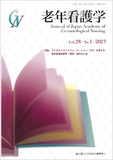Japanese
English
- 販売していません
- Abstract 文献概要
- 参考文献 Reference
抄録
本研究の目的は,特別養護老人ホーム(以下,特養)入居者のエンドオブライフにおけるケアニーズの構造を明らかにし,入居時から死亡までのケアニーズに基づくケアの体系化への示唆を得ることである.特養での看護経験があるエキスパート看護師36人を対象にフォーカスグループインタビューを実施し,語られた118事例を質的帰納的に分析した.特養入居者のエンドオブライフのケアニーズは,【いつもと違う症状を言語で表出できない】【身体機能が低下し続け新たな健康障害が生じる】【痛みと意欲低下により動くことが難しい】【嚥下機能が低下し満足できる食事摂取が難しい】【不安で気持ちが落ち着かない】【安らかに最期までなじみの場で過ごすことが難しい】の6カテゴリーが互いに影響し合い,コンフォートな状態を目指す際のケアの必要性が拡大していく構造が示された.その根本には,避けることができない老衰がある.生活の延長線上で死を迎えるまで,急変の回避や苦痛の低減などを意図した高度な予後予測と適切な判断をもとに,長期的にケアニーズを充足する援助が必要である.
This study clarified the structure of the end-of-life care needs of residents in nursing homes, and obtained suggestions for the systematization of care based on care needs from the time of their admission to death. Focus group interviews were conducted with 36 expert nurses with nursing experience in nursing homes. A total of 118 cases were analyzed qualitatively and inductively. The end-of-life care needs of residents in nursing home were as follows: [inability to verbally express abnormal symptoms], [new health problems following the continued decline in physical functions], [difficulty moving as a result of pain and decreased motivation], [difficulty eating satisfactorily consequent to decreased swallowing function], [anxiety and restlessness] and [difficulty in spending time in a familiar place until the end of life]. The structure of care needs revealed that these six categories interacted with each other, and the lack of care that effectively met the needs of the residents expanded. At the root of this dilemma is the inevitable senility faced by most residents, which requires assistance based on an advanced predictive judgment to prevent the expansion of the care needs by avoiding sudden changes during their stay and reducing the total pain they experienced until death as a way of extending their lives.
Copyright © 2023, Japan Academy of Gerontological Nursing All rights reserved.


